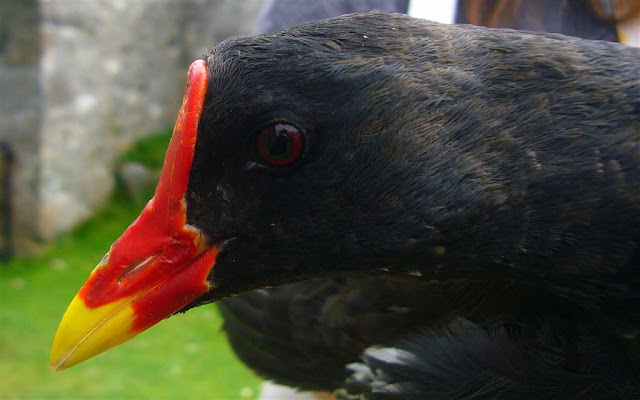Do you remember the Puss Moth that I (Gis) found at the beginning of the month? She appeared to be on her last legs, with very worn wings. Another clue that she wasn't very healthy was the fact that she'd laid several eggs on rushes, which aren't the food plant of this species.
Puss Moth with eggs. (c) Richard Brown
As the field was stocked with sheep, we decided to borrow a few of the eggs, to see if they would hatch. Rich had a theory that they might be sterile because he had once found a Northern Eggar, also on its way out, laying eggs in unsuitable habitat, and those eggs hadn't hatched. We took one rush with 14 eggs on, leaving around 30 in the field, and put them in a jam jar with some willow and left them alone. When they still hadn't hatched by the end of the week we were starting to think that Rich was right, but on Sunday morning, not one, not two but three caterpillars were creeping around the top of the jam jar!
A newly emerged Puss Moth Caterpillar. The long red and orange tail streamers are used as a defence mechanism but take some time to dry and straighten out after they've hatched. Further up the stem is the head of another caterpillar about to hatch! (c) Richard Brown.
All 14 hatched successfully (with the last runty one needing a hand a day later because he had another hatched egg blocking his escape hole). They're now all munching happily on willow leaves. They should eventually undergo a couple of skin shedding episodes, and turn into the classic green caterpillar off of the famous book 'The Very Hungry Caterpillar'. We wont be feeding pies or cheese to ours though. (c) Richard Brown
Avian wise on the island, it is another ridiculously quiet day, with the apparent highlight being a
Yellowhammer at the farm. Yesterday was similar, but we did manage to catch a
Moorhen, which was the 50th species to be ringed on the island this year!
I wore an old apron to ring it, as I had been warned that Moorhens have a tendency to leak. They also have a tendency to kick, so it was a refreshing change from the placid Willow Warblers that neither leak nor kick. This one was sexed as a male, based on its wing length and tarsus and toe measurement. It had evidence of juvenile plumage so had hatched sometime last year. (c) Richard Brown
We've had a good ringing year so far, and calm April days meant that many of the passage migrants could be easily mist-netted. A whopping 1143 new birds were ringed in April, with a current total of 1657 so far. Unfortunately the persistent wind at the beginning of May meant we couldn't open the nets, and so few birds were ringed. Now that the wind has died down, it seems there are no birds to catch. But as Rich always tells me, "Le Grande Un travels alone". As his French accent isn't the best, for months I thought he was saying "The Grand Urn Travels alone" and I didn't have the heart to ask what he was on about. Anyway, I digress. Watch this space because le Grande Un is coming!






















































